Many countries in the world have a “Blue Plaque” scheme which involves hanging a blue plaque to commemorate a person of note living in a building. Britain is the oldest such scheme in the world, and Brighton began a rollout of these plaques back in 1923. There are a huge number of them around the city now.
To get you excited about them, we’ve compiled a list of the 25 most famous blue plaques in Brighton who are they? They include
- Fanny Burnley
- Charles Dickens
- Author, George Canning
- Prime Minister, Lewis Carroll
- Author, William Ewart Gladstone
- Martha Gunn
- Samuel Johnson
- Sir Edwin Landseer
- Eleanor Marx
- Women’s Rights Campaigner
- Harriet Melon
- Max Miller
- Sir Laurence Olivier
- Terrence Rattigan
- Magnus Volk
- King William IV & Queen Adelaide
- Anita Roddick
- John Russell
- Doreen Valiente
- Enid Bagnold
- Rudyard Kipling
- Sir Winston Churchill
- John Hindmarsh
- Jack Hobbs
- John Constable
Read on to hear about some of our favourite famous Brightonians of yesteryear.
Brighton’s 18 Most Famous Plaques
The town of Brighton has been host to a wealth of important people over the centuries, and there are far more blue plaques than we can list here. Fortunately, there is a definite pecking order, and we’ve listed the people with the biggest reputations. Many of the others were famous and influential in their day but no longer have as much impact as those on our lists.
Fanny Burney, “The Mother Of English Fiction”
Evelina, A Young Lady’s Entrance Into the World, was one of the first novels to be published in the UK to be written by a woman, and it is an incredibly skilful portrayal of many different characters. It is a truly great novel and led to Fanny Burney being dubbed “the mother of English fiction”. She wrote many other plays and novels, and while her name may not fall from the tongue easily today – she was hugely influential on the whole literary scene.
– 77 West Street
Charles Dickens, Author
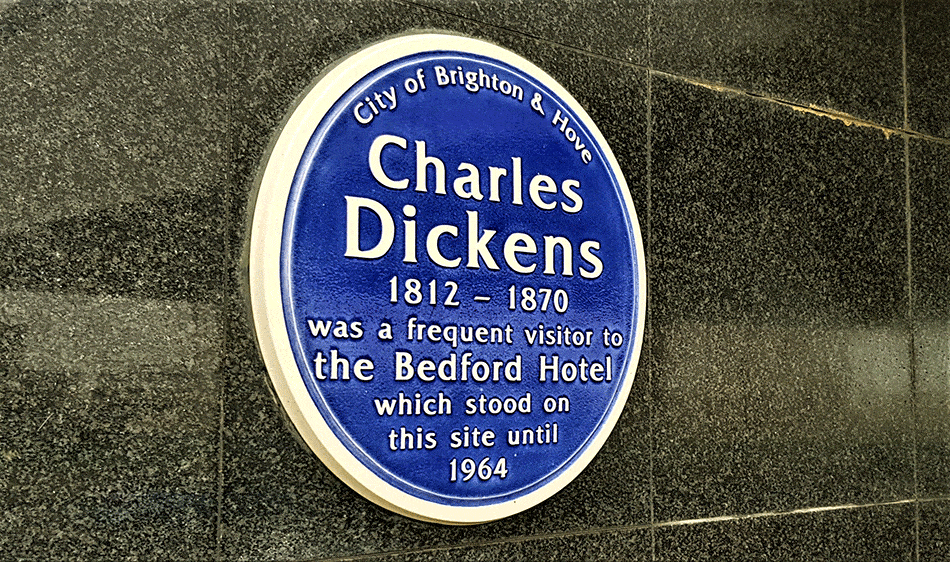
After Shakespeare, there may be no more famous author in British history than Charles Dickens. His works served as social criticism in his day, and he achieved huge popularity in his lifetime, which has lived on to this very day. The Pickwick Papers, David Copperfield, A Christmas Carol, Oliver Twist, Great Expectations and A Tale of Two Cities are all well-known literary titles to this day.
– Holiday Inn, Brighton
George Canning, Prime Minister
It would be a brave soul to try and rattle off a list of all the Prime Ministers of the United Kingdom, but it would be hard to deny their impact on British life. However, George Canning will forever be remembered as the Prime Minister to serve the fewest days in office as his health failed after getting the job, and he died 119 days later.
– Royal Crescent Hotel, Marine Parade
Lewis Carroll

One of the few writers with the literary clout to challenge Dickens would be Lewis Carroll, his Alice’s Adventures in Wonderland is one of the best-known books in the world and has inspired movies, TV series and even computer games galore. He was also a mathematician, photographer and, of course, a deacon of his parish.
– 11 Sussex Square, Kemptown
William Ewart Gladstone, Prime Minister
– Adelphi Hotel, Pool Valley
Gladstone was a top-tier British statesman and Prime Minister for 12 years and was elected to the job 4 times. He was responsible for major social reforms and was considered one of historians’ greatest leaders of all time. He was “The People’s William”. He dies at the age of 88 of “advanced age”.
Martha Gunn, Queen of the Dippers
One of Brighton’s most famous women was Martha Gunn. Her job was to (wo)man the bathing machines that enabled women to “protect their modesty” whilst bathing on Brighton Beach. The women would be stuffed into a bathing machine and then “dipped” into the water. Martha managed the dippers, and her role was featured in 1998’s adaption for the silver screen of Vanity Fair.
– 36 East Street
Samuel Johnson, Lexicographer
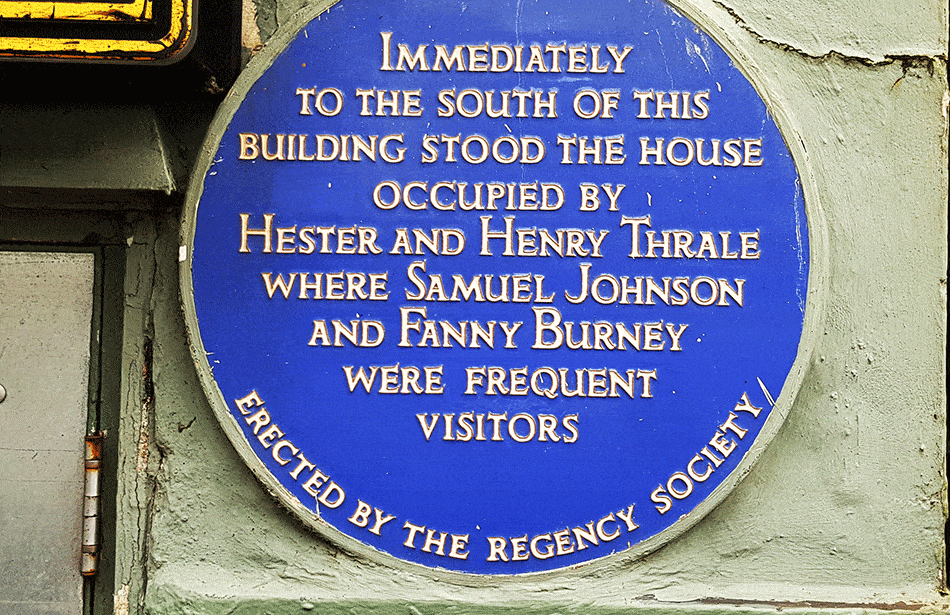
– 77 West Street
Dr Johnson, as he was known to the British public and the wider world, was responsible for huge contributions to English literature and to the language itself. His “A Dictionary of the English Language” is considered the single greatest act of scholarship in pursuing the language. He was well-respected by his peers, and his legacy lives on today.
Sir Edwin Landseer, Artist
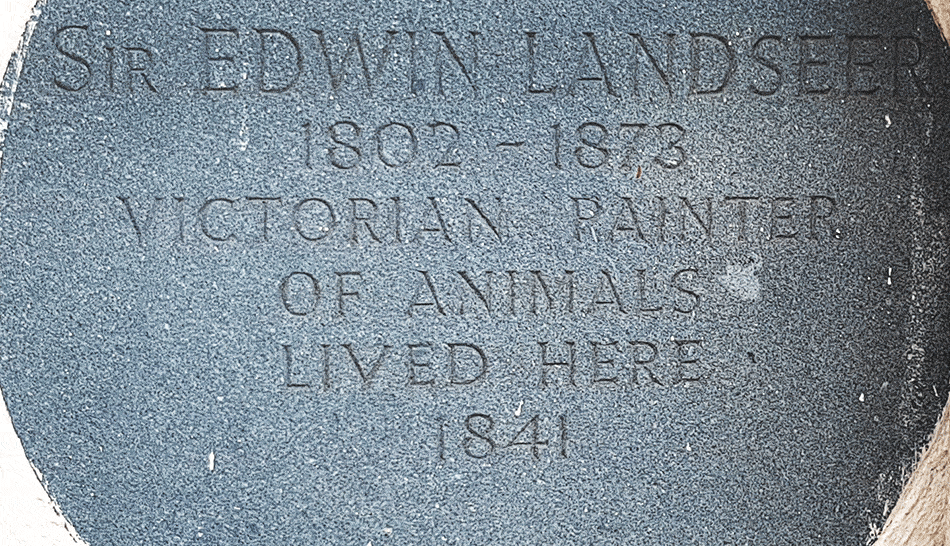
Sir Edwin Landseer was a very well-known artist during his day, but his animal paintings are not so well known today. What is, however, most memorable about his work is the pair of lion sculptures which adorn Nelson’s Column, which stands in Trafalgar Square in London. When he passed away in 1873 the country went into mourning for him. He is buried at St. Paul’s Cathedral.
– 65 – 66 Regency Square
Eleanor Marx, Women’s Rights Campaigner
One of the earliest feminist campaigners, Eleanor Marx, is only overshadowed by the fact her father is that Karl Marx, who founded the communist movement around the world. She was a driving force in British socialism and is fondly remembered. Sadly, it is possible that she was murdered by her lover Edward Aveling a notorious conman.
– 6 Vernon Terrace
Harriet Mellon, “The Wealthiest Woman in Europe”
Harriot Mellon would die Harriot Beaucleark, the Duchess of St Albans. She began as an actress and was painted by the best painters in England because of her beauty. Then she married Thomas Coutt the banker who founded Coutt’s and Co (the Royal Family’s bank) and when he died in 1822 and left her his fortune, she became “The Wealthiest Woman in Europe”.
– 131 Kings Road
Max Miller, Comedian/Entertainer

– 25 Burlington Street
“The Cheeky Chappie,” Max Miller, was the greatest comedian of his age. He was a music hall entertainer and stand-up comic who would regularly get into trouble with the censors of the day. In 1999, the Max Miller Appreciation Society opened in Brighton to try and ensure that his work remains in current memory.
Sir Laurence Olivier, Actor/Director

– 4 Royal Crescent
An actor who won 4 Academy Awards, 5 Emmy Awards, 3 Golden Globes and two British Academy Film Awards and who received a knighthood, the Order of Merit and a life peerage needs no explanation as to how successful he was. The movie industry may have a regular changes in billing, but some stars last forever.
Sir Terrence Rattigan, Playwright
The Deep Blue Sea is probably Sir Terrence Rattigan’s most famous work. He was one of the most influential playwrights of the mid-20th century in the United Kingdom. His personal life was one of some strife due to his sexuality. He passed away in Bermuda, of all places, aged just 66.
– 79 Marine Parade
Magnus Volk, Engineer
Brighton’s most famous electrical engineer was Magnus Volk, Volk’s electric railway is still in operation in Brighton, and you can see the bare bones of another one of his, sadly failed, railway projects nearby too. It should come as no surprise that he lived in the city.
– 128 Dyke Road
King William IV & Queen Adelaide
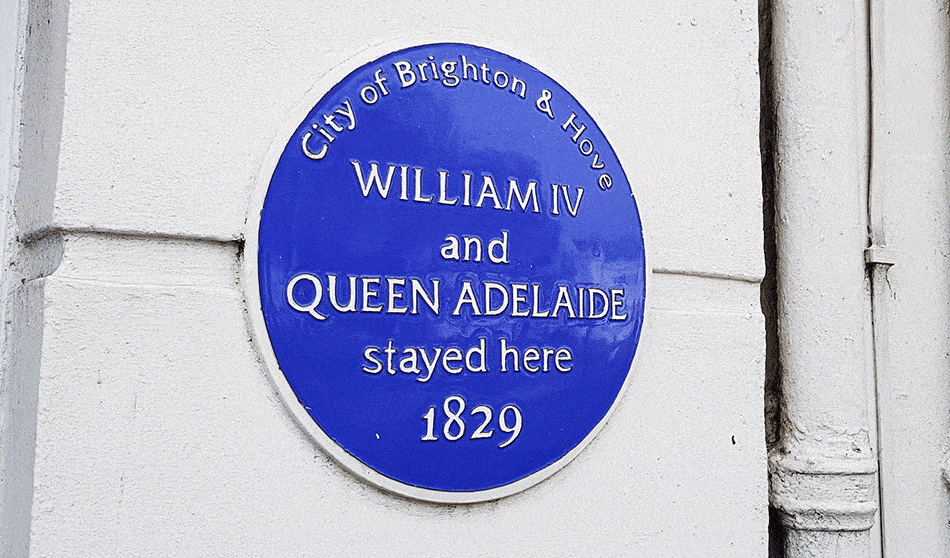
– YHA Brighton, Old Steine
King William IV ascended to the throne at 64, making him the oldest person to become king of England. He would be followed to the throne by Queen Victoria, who probably wasn’t amused. However, King William IV & Queen Adelaide regularly visited Brighton and loved to stay in the city.
Anita Roddick, Founder of The Body Shop
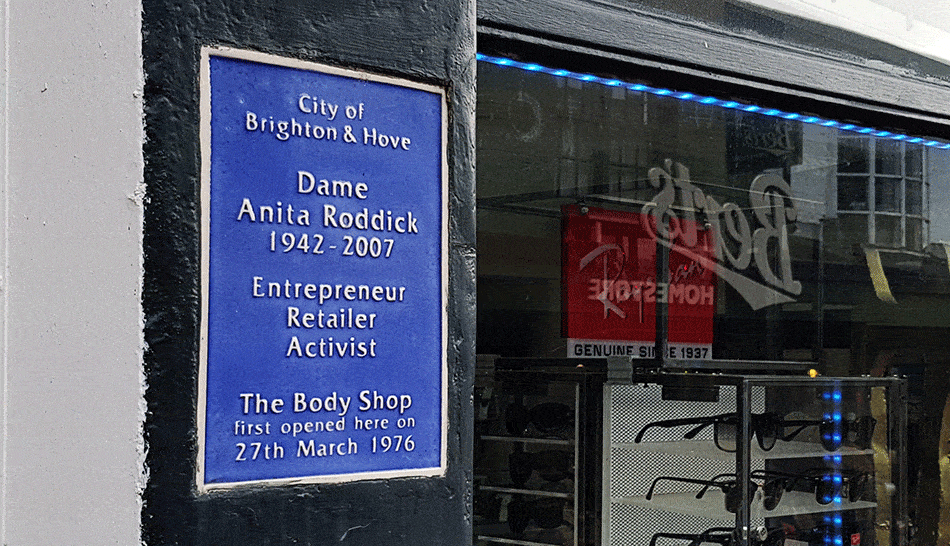
– 22 Kensington Gardens
Dame Anita Lucia Roddick was one of the first major environmentalists in the UK. She founded The Body Shop, which excelled in natural and ethical products for men’s and women’s beauty and skincare regimes. She was a strong believer that business can offer moral as well as financial leadership. Her first shop was in Brighton’s The Laines. Today, The Body Shop has more than 2,000 outlets worldwide!
Lord John Russell, Prime Minister (Twice)
It’s a rare Prime Minister who gets two cracks of the whip. Though it’s a feat managed by another famous local resident, Sir Winston Churchill. His first time as premier saw him implement significant social reforms, his second time around was short and frustrating, and his government was brought down before the end of his term.
– 14 Sussex Square, Kemptown
Doreen Valiente, “Mother of Modern Witchcraft”
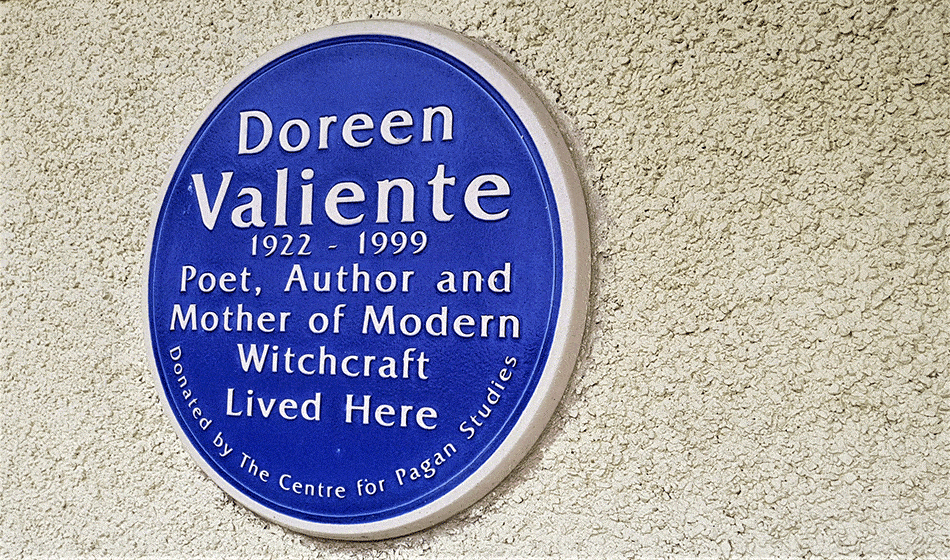
– Tyson, Place
It’s not often you get to cite a famous witch but Doreen Edith Dominy Valiente was just that. She was a Wiccan practitioner who was responsible for the resurrection of interest in the faith during the 20th century. She also published 5 books on the subject of witchcraft!
Rottingdean’s 2 Most Famous Blue Plaques
Rottingdean is only a little village just outside Brighton, but it has six blue plaques, and 2 of which are from very notable people. It’s worth taking a look for them if you’re doing the Brighton to Rottingdean or Hove to Rottingdean cycle routes.
Enid Bagnold, Author
Enid Bagnold would, in any other city, be a major literary figure. Her work National Velvet is well-loved, and the story of a young girl raising a Grand National winner has been adapted for stage and film. Sadly, for Enid, she hails from Brighton, and she’s just another exceptional talent from a city with so much talent to offer.
– Aubrey House
Rudyard Kipling, Writer
Rudyard Kipling’s If is perhaps the most famous poem in British history and is certainly among the most quoted. His “Just So” stories and “The Jungle Book” are still beloved by children the world over, and his other literary contributions like “Kim” are still well-regarded. He was a huge talent that lives on in the public’s imagination today.
– The Elms, The Green
Hove’s 5 Most Famous Blue Plaques
Hove also has a large number of blue plaques though it doesn’t have quite as many “big names” as Brighton – it does have, possibly, the biggest name of them all – Sir Winston Churchill, the legendary statesman who navigated the Allied Forces successfully through the 2nd World War and brought about the end of fascism.
Sir Winston Churchill, Prime Minister and Author
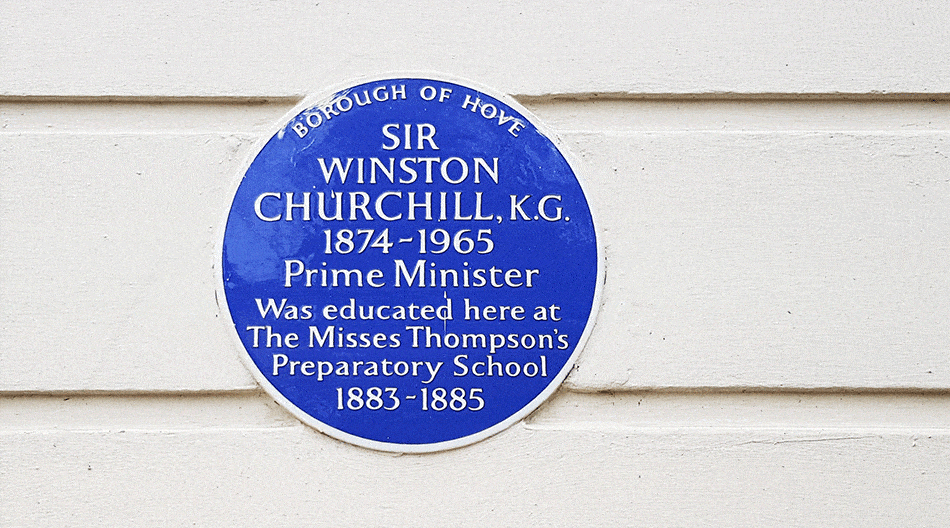
You can, and people have written several books summing up the achievements of Sir Winston Churchill. So, it’s hard to capture the two-time Prime Minister and world-class statesman in a paragraph. So, we’re going to point out that his “History of the English-Speaking People” may be one of the most valuable contributions to human knowledge that any prime minister has ever made.
– 29-30 Brunswick Road
Sir John Hindmarsh, Governor of the State of South Australia
Sir John had an influential career in the Royal Navy before being knighted in later life. He lost an eye during the Battle of the Nile. His reputation was so great in the UK, however, that his injury did not end his career, and eventually, he sailed for South Australia on the HMS Buffalo to take up a position as the Governor of the State of South Australia. He remains one of only two people to ever have seven clasps (each one representing a battle fought in) on their Naval General Service Medal.
– 30 Albany Villas
Sir Jack Hobbs, England and Surrey Cricketer – 13 Palmera Avenue
Sir Jack Hobbs, or “The Master” as they called him on the cricket pitch, is widely regarded as one of the greatest batsmen that England has ever seen. He made 88 on his debut and would top a century for Sussex in his next game. He scored three test centuries against Australia, which had him adjudged the “world’s best batsman” for his era. Cricket fans still praise his contributions to the game.
Sir (Admiral) George Westphal, Naval Officer
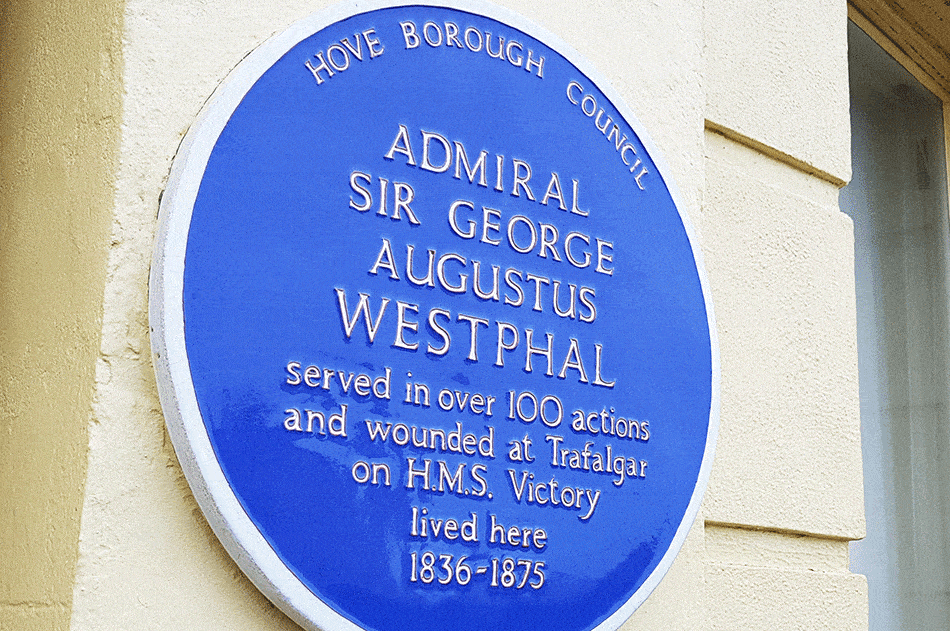
Sir George Westphal may put Sir John Hindmarsh to shame as he served in more than 100 fighting actions for the Royal Navy! He was aboard Nelson’s Victory at the Battle of Trafalgar and served on many other vessels during his distinguished career. He retired to Hove and lived there for nearly 50 years until his death. He was only promoted to Admiral after he had retired.
– 2 Brunswick Street
John Constable R.A., Artist
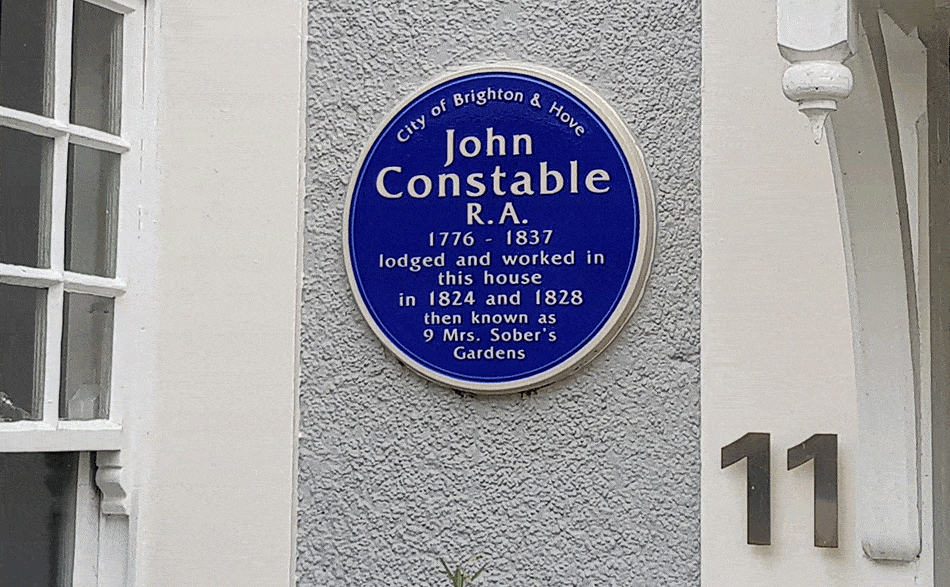
Constable may be Britain’s most famous artist of his period and is possibly only eclipsed by Banksy in the modern day. The Hay Wain is his best-known work, but he was never a financial success during his lifetime. Though he was elected to the Royal Academy, finally, when he turned 52.
– 11 Sillwood Road
A Full List of Brighton and Hove’s Blue Plaques
There are a lot of blue plaques in Brighton and Hove, this is despite the fact that each one requires nomination by a member of the public, approval by a board and then a £1,200 administrative donation to get the plaque made and mounted on the wall of the property.
There are more than 130 of these plaques in total, and you can find a full PDF list of them on the local authority’s website here.
If you’d like to get out and see the blue plaques, then we can think of three good walking routes where you can see a good number of them. The first begins in Old Steine, and you can download a full itinerary here. The second is in Palmeira Square, and you can get your itinerary here. And the third in Camelford Street with an itinerary here.
Conclusion
As you can see, Brighton has been home to some very famous and important people over the years. We hope that our guide to “The 25 Most Famous Blue Plaques In Brighton And Who Are They?” has been helpful in sparking your interest in blue plaques in the city. Given the number of well-to-do folk living in the city today, we can only anticipate that their numbers will increase for a long time.


